Smugglers, Alien Vampires, and Dark Dimensions: The Best of C. L. Moore
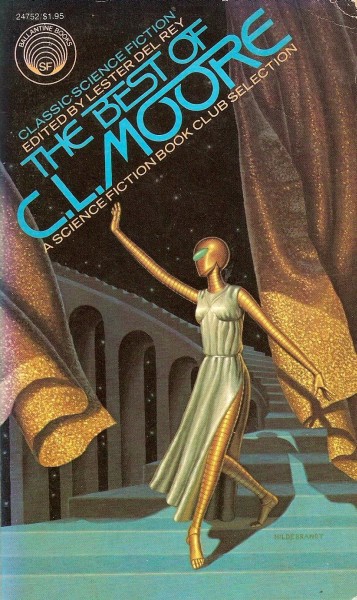 |
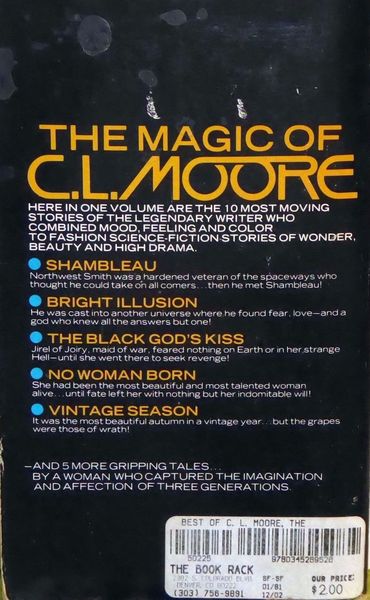 |
The Best of C. L. Moore (1976) was the sixth installment in Del Rey’s Classic Science Fiction Series. After taking a break from the fifth installment to let J. J. Pierce edit, Lester Del Rey (1915–1993) returned to edit and give an introduction to this volume.
You may recall that Dean Ellis (1920–2009) did the cover art for the first four installments in the series with Darrell Sweet handling the fifth, though still in the style of Ellis. But the fabulous cover art of The Best of C. L. Moore was done by “The Brothers Hildebrandt” (twin brothers Greg [1939–] and Tim [1939–2006]) and represents something of a departure from the artistic precedence of Ellis and Sweet. It’s a portrait of the main character in Moore’s story, “No Woman Born.”
Catherine Lucille Moore (1911–1987) was one of the greatest science fiction and fantasy writers of the Twentieth Century. Writing under the name C. L. Moore, she was one of the first truly successful women writers in genre fiction, gracing the early pages of Weird Tales and Astounding Stories. She was also was famously married to another well-known sci-fi writer, Henry Kuttner (1915–1958), whom she collaborated with on many stories. However, all but two of the tales in The Best of C. L. Moore were written before her time with Kuttner. As with the previous books published while the featured author was still alive, Moore has a small afterword at the end.
[Click the images for bigger versions.]
Before I read this volume, I was really only familiar with Moore through her oft-anthologized story “Black God’s Kiss,” which is included here. I was expecting more of the same enjoyable writing, and I was not disappointed. Moore is clearly a master, and in many ways a much more subtle writer than the typical sci-fi writers of her time. I found her to be very nuanced, focusing more on character and innuendo than action or dialogue. These factors make The Best of C. L. Moore an excellent collection of stories. I will focus on just a couple that really stuck out for me.
The first story, “Shambleau,” was evidently something of a blockbuster back in 1933, and at the time seemingly came out of nowhere. Lester Del Rey recounts in the introduction the anticipation of the audience at a later World Science Fiction Convention banquet, which captures the effect that story had on the field:
I sat in the audience… listening to Forrest J. Ackerman announce a special award that was about to be presented to a writer. As is customary, Ackerman was saving the name of the recipient for the climax. But he mentioned a story called “Shambleau” and never got to finish his speech. As one, the 2,000 people in the audience came instantly to their feet in unanimous tribute — clapping, shouting, and craning to see [C. L. Moore].
Many in that audience had never read the story. But everyone knew about it. And everyone knew that Catherine Moore was one of the finest writers of all time in the field of science fiction.
It is probably impossible to explain to modern readers how great an impact that first C. L. Moore story had. Science fiction has learned a great deal from her many examples. But if you could go back to the old science-fiction magazines of the time and read a few issues, and then turn to “Shambleau” for the first time, you might begin to understand. (ix–x).
Being a modern reader, I probably can’t truly appreciate the point Del Rey is making here. But “Shambleau” is a truly engaging story set in a futuristic time about a swashbuckling adventurer (think Han Solo) who rescues a beautiful alien girl from a mob.
Northwest Smith and Shambleau (art by Jim Burns)
Throughout many of her stories, Moore does an exceptional job of describing the beauty of women, much better than many male writers. Thus, Moore makes it clear why the protagonist in “Shambleau” is drawn to this alien “witch.” But he gets more than he bargained when he saves her, and eventually realizes the mob may have been right in their attempt to lynch this alien woman. The ending reminded me of H. P. Lovecraft.
My favorite C. L. Moore story though, both before and after reading The Best of C. L. Moore, was easily “Black God’s Kiss.” This is one of those tales that fits squarely into what we recognize today as Sword and Sorcery. It introduces Jirel of Joiry, a sword-wielding female knight. Jirel is a recurring character in many of Moore’s stories, although this is the only one I’m familiar with. Here Jirel is taken captive by a conquering knight and she seeks a weapon to bring vengeance against this conqueror. The weapon she seeks exists in a hellish world of some other dimension. But her burning need for revenge outweighs the fear she should probably have in seeking to fulfill this quest.
Art by Margaret Brundage
As with “Shambleau,” “Black God’s Kiss” is also very effective in presenting horrific elements. And as with “Shambleau,” Moore’s description of this world and its demonic denizens reminded me very much of Lovecraft. But Moore is very effective in combining horror with fantasy, and “Black God’s Kiss” never feels like it leaves the realm of Sword and Sorcery. An excellent, excellent story! I cannot expound enough on it. I especially like the poignant regret Jirel seems to hold at the end.
The Best of C. L. Moore is filled with other gems as well, though. “Fruit of Knowledge” is a retelling of the biblical story of Adam and Eve, along with the medieval Jewish myth of Lilith. This was very interesting and different sort of tale — not the kind of thing you’d normally expect in a fantasy or sci-fi anthology.
I also really enjoyed “Vintage Season,” about time-travelers who arrive at famous historical events just before they happen. The focus upon characterization and the subtle interaction between characters is very good — something that truly shines in Moore’s writing. I think this is what Del Rey was referring to in claiming that Moore was really different from most of the sci-fi writers that preceded her.
One caution, though. Moore’s stories are rarely, as a rule, harum-scarum wild rides of action and excitement. She is a patient and methodical writer. I say this because I’ve recently been reading a lot of Robert E. Howard, who is very fast-paced. When I turned to C. L. Moore, I often found myself growing impatient with the amount of time she spent developing characters and various small details. It took me a little while to slow down and enjoy Moore. But once I did, I found this volume to be a splendid collection of fabulous stories.
The Best of C. L. Moore is a great volume of classic sci-fi and fantasy stories from one of the twentieth-century’s greatest masters. I highly recommend it.
Here’s the complete Table of Contents:
“Forty Years of C. L. Moore,” introduction by Lester del Rey
“Shambleau” (Weird Tales, 1933)
“Black Thirst” (Weird Tales, 1934)
“The Bright Illusion” (Astounding Stories, 1934)
“Black God’s Kiss” (Weird Tales, 1934)
“Tryst in Time” (Astounding Stories, 1936)
“Greater Than Gods” (Astounding Stories, 1939)
“Fruit of Knowledge” (Unknown, 1940)
“No Woman Born” (Astounding Science Fiction, 1944)
“Daemon” (Famous Fantastic Mysteries, 1946)
“Vintage Season” (Astounding Science Fiction, 1946)
A few Best of Collections from the 70s-80s
Our previous coverage of the Classics of Science Fiction line includes (in order of publication):
- Rich Playboys, Mad Scientists, and Venusian Monsters: The Best of Stanley Weinbaum by James McGlothlin (1974)
- A Neglected Master: The Best of Henry Kuttner by James McGlothlin (1975)
- A Shaper of Myths: The Best of Cordwainer Smith by James McGlothlin (1975)
- Smugglers, Alien Vampires, and Dark Dimensions: The Best of C. L. Moore by James McGlothlin (1976)
- Space Colonies, Interstellar Fleets, and The Martian in the Attic: The Best of Frederik Pohl by James McGlothlin (1976)
- Classic SF from One of the Twentieth Century’s Great Masters: The Best of John W. Campbell by James McGlothlin (1976)
- Shark Ships and Marching Morons: The Best of C. M. Kornbluth by James McGlothlin (1977)
- Drawing Out What it Truly Means to be Human: The Best of Philip K. Dick by James McGlothlin (1977)
- Wit and Play in Classic Science Fiction: The Best of Fredric Brown by James McGlothlin (1977)
- Wings, Wind, and World-Wreckers: The Best of Edmond Hamilton by Ryan Harvey (1977)
- Dead Cities, Space Outlaws, and Planet Gods: The Best of Leigh Brackett by Ryan Harvey (1977)
- From the Pen of a Great Pulpster: The Best of Robert Bloch by James McGlothlin (1977)
- Germ Warfare, Sentient Planets, and Dark Age Alchemy: The Best of Murray Leinster by James McGlothlin (1978)
- Dinosaurs, Mermaids, and Haunted Lumber: The Best of L. Sprague De Camp, by James McGlothlin (1978)
- The Best of Jack Williamson by John O’Neill (1978)
- Davey Jones, Alien Spores, and Riding on a Comet: The Best of Raymond Z. Gallun by James McGlothlin (1978)
- Gods, Robots, and Man: The Best of Lester del Rey by Jason McGregor (1978)
- Space Empires, Ruined Civilizations, and Lovable Aliens: The Best of Eric Frank Russell by James McGlothlin (1978)
- The Best of Hal Clement by John O’Neill (1979)
- The Best of James Blish by John O’Neill (1979)
- Vampires, Frozen Worlds, and Gambling With the Devil: The Best of Fritz Leiber by James McGlothlin (1979)
- The Best of John Brunner by John O’Neill (1988)
See all of our recent Vintage Treasures here.
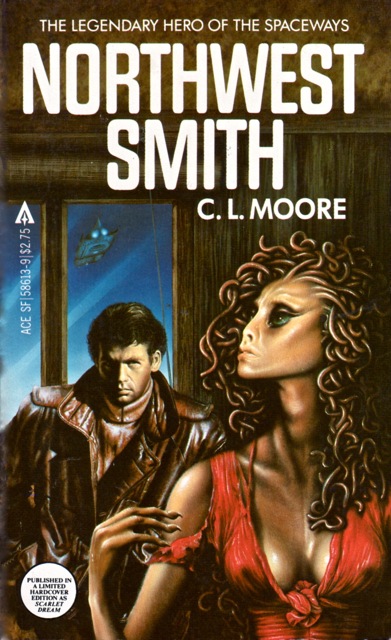
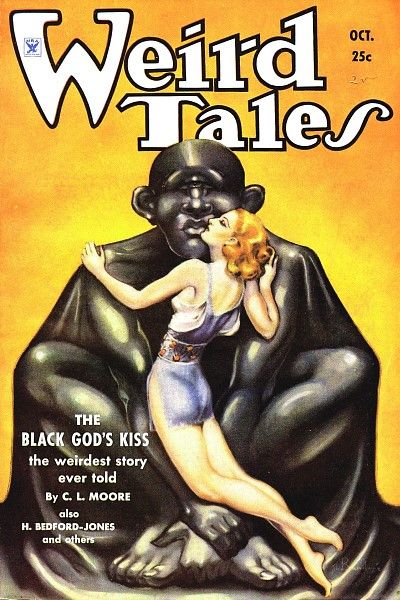
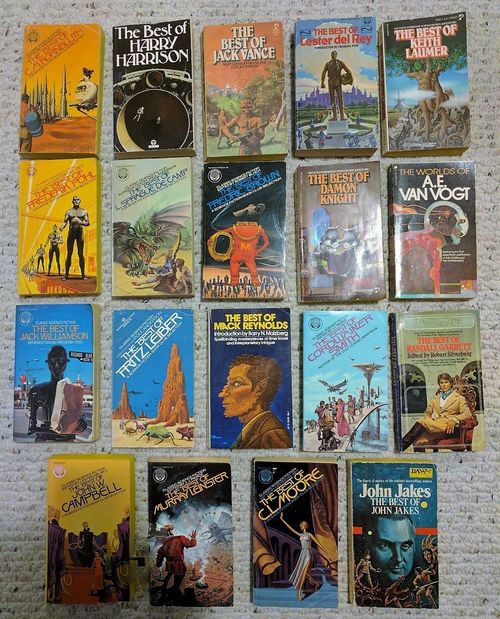
I’m pretty sure I read this one back in the day — I remember the cover vividly, although to recreate the effect the bottom bit should be obscured by a wraparound Austin Public Library sticker.
The night after I first read “Shambleau,” I had the most extraordinarily vivid nightmare I’ve ever had, quite clearly based on the tale. Now THAT’S writing!
When my monthly reading group did Lavie Tidhar’s Central Station last year, I brought my copy of The Best of C.L. Moore to help explain the significance of the “shambleau” character, and Tidhar’s re-imagining of same. Alas, I was unable to impart to them the same level of excitement that I had on encountering either the classic or the contemporary “shambleau”.